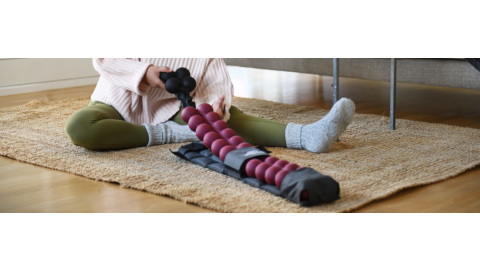Even though tennis has a low injury rate, with player numbers more than double the population of the Greater Toronto Area, it’s not surprising that the statistics show that many players suffer from injuries during practices and matches.1
If your patient or athlete is experiencing pain from tennis, try these products to get relief! Then learn how to prevent injury in the future so your patients can stay on the court and off the sidelines.
Pain Relief and Prevention for 7 Common Tennis Injuries
1. Tennis Elbow
Pain Relief
Two-thirds of tennis injuries are due to overuse.2 One common overuse injury is tennis elbow, a condition that causes pain on the outside of the elbow. While ice and other pain relievers can temporarily relieve pain, doing Tyler Twist exercises with the research-proven THERABAND® FlexBar can help relieve the pain for good. For pain relief while playing, have your athlete wear a Cramer Tennis Elbow Strap to provide compression and help reduce pain.
Injury Prevention
To prevent tennis elbow in the future, make sure your athlete warms up before practices and matches. Additionally, have them try to reduce the repetitive movement that caused them pain in the first place. Read this article to learn more about how to treat tennis elbow.
2. Ankle Sprains
Pain Relief
Ankle sprains, the stretching or tearing of ankle ligaments, are another common tennis injury. Relieve the pain by following the RICE (rest, ice, compression, elevation) acronym. Rest, apply ice to the ankle, wrap it with a bandage to apply compression, and keep the sprain elevated above the heart.
Injury Prevention
Your patient should start basic rehabilitation exercises in the first 72 hours after the sprain occurred to prevent re-injury and ensure the ankle fully heals. Start basic weight bearing exercises, then strengthen your ankle with these exercises using a CLX® resistance band. Don’t forget to have your patient wear a supportive brace, like the Active Ankle T2 Brace, for extra protection while in play.
3. Stress Fractures
Pain Relief
Stress fractures are small cracks in the bone caused by overuse (like running and jumping on hard tennis courts). This painful injury may occur in the foot, leg, or lower back of tennis players. The best remedy is rest. Apply cold packs to the injured area to relieve the pain. More serious fractures may require a boot to immobilize the affected area during the healing process.
Injury Prevention
Prevent stress fractures by having athletes take the time to warm up and stretch before playing and take rest breaks as needed. Don’t increase the workout intensity all at once—do it slowly. And be sure to mix low-intensity swimming, biking, and other activities with high-intensity tennis practices. Following these guidelines can help reduce the chances of a stress fracture in the future.
4. Shoulder Injuries
Pain Relief
Using the shoulder muscles is a crucial part of playing tennis, which is why overhead slams, serves, and other repetitive tennis strokes can cause shoulder injuries. Once again, rest is an important part of the healing process. Use cold packs designed for the shoulder to relieve your patient’s pain, or recommend they wear a shoulder support brace during recovery.
Injury Prevention
There are many stretches and exercises your athlete can perform to prevent shoulder injuries. Resting and alternating tennis sessions with other activities can also help reduce the risk of rotator cuff injuries or shoulder impingement.
5. Back Pain
Pain Relief
If your back aches after a vigorous practice or match, get relief with Biofreeze. The topical analgesic is easy to apply - just spray it onto your back for cooling relief. It can also be used on any sore muscles. If you’re looking for another pain relief solution, try a TENs unit. The device applies transcutaneous electrical nerve stimulation to relieve your patient’s pain.
Injury Prevention
Looking to prevent back pain? Make sure to have your patients stretch before they start playing. Having a strong core and proper form can also keep the back healthy, so focus on core and back exercises and regularly check your athlete’s tennis form. Build up to exercises that put more strain on the back, like serves, low or wide volleys, and high topspin backhands. Train volleys and overheads in separate sessions because they are both stressful for the back. Having your patients play on clay instead of hard courts can also reduce back strain.
6. Foot Pain
Pain Relief
Because tennis involves a lot of quick footwork and time spent on your feet, it can lead to foot pain. Massage is a great way to relieve foot pain. The THERABAND Foot Roller is an easy way to apply gentle pressure or a rolling massage. It can even be frozen for additional pain relief. For heat or cold therapy, try Sammons Preston Hot and Cold Combo Packs. The variety of designs and sizes allow for muscle treatment and relaxation from head to toe, as the packs are designed to say in place on the body.
Injury Prevention
To prevent foot pain, make sure your athlete wears supportive tennis shoes that fit properly. Different types of shoes are designed for different courts. Hard court shoes have a durable sole to stand up to the court’s surface and some cushioning to protect the joints. Shoes designed for clay courts have patterns (usually herringbone) on the sole to grip the court without retaining clay. They also have lateral support due to the sliding that may occur. Finally, grass court shoes typically have short, rubbery nubs/cleats that can grip a slippery grass surface. Choosing the proper shoe and adding supportive orthotics can help reduce the risk of foot and ankle injuries.
7. Muscle Soreness
Pain Relief
Are long practices and strenuous matches leaving your athletes with sore muscles? While massage is one simple solution for their pain, foam rollers can also be used to massage sore tissue and muscles. To target specific areas for a more focused massage, use a THERABAND Massage Roller+. And for quick relief, use cooling Biofreeze gel!
Injury Prevention
Sore muscles are common after working out or playing sports, like tennis. If your athlete did something they’re not used to, like playing more matches than usual, or increasing practice intensity or length, they’ll probably end up with sore muscles. Over time, their muscles will start to get used to the activity and their soreness should lessen. Minor soreness is a good thing because it means the muscles are growing stronger. Start treatment if the athlete’s soreness doesn’t go away or if it prevents them from going about their daily life.
Risk Factors for Tennis Injuries
Some factors make it more likely for athletes to become injured while playing, so educating them about these factors allows them to make smart choices to reduce their risk of injury. These risk factors include:
- Condition of tennis balls (pros switch them every seven games)
- Tennis technique
- Type of racquet
- Court surfaces (hard courts are harder on joints while grass courts are slippery)
- Inappropriate shoes
- Poor injury rehab
- Inadequate physical conditioning
- Amount and level of participation
- Weather
Tips to Avoid Tennis Injuries
Reduce an athlete’s risk of painful injuries by having them follow these tips:
- Stretch and warm up before playing and cool down afterwards
- Condition and train to maintain a good fitness level
- Practice good technique and get tips from a coach to correct problem areas
- Avoid over-repetition of one shot during practice – mix it up and practice a range of shots
- See a doctor to keep your minor injuries from becoming chronic or more severe
Recap
Tennis should be fun, not painful. By having the right tools and techniques, you can make sure your athletes are swinging at full force. Whether it’s tennis elbow, back pain, or ankle sprains, stay prepared for any injuries your athletes may sustain.
References
- “Tennis Participation in Canada.” Adrenalin Magazine. Ignite Magazine. Retrieved from https://bit.ly/3CkTGNB
- Stop Sports Injuries. (n.d.). Preventing Tennis Injuries. Retrieved from https://bit.ly/2GqMfGK
- Sports Medicine. (2018). How to Prevent 4 Common Tennis Injuries. UPMC Health Beat. Retrieved from https://upmc.me/32NdiWb
- International Tennis Federation. (n.d.). Lower Back Pain. Retrieved from https://bit.ly/2YcaVbW
- Bowen, C. (2017). Is it important to wear court shoes while playing tennis? Retrieved from https://bit.ly/30OH8YH
- Sarnataro, B. R. (n.d.) Sore Muscles? Don’t Stop Exercising. Retrieved from https://wb.md/2OfAh95
- Miller, J. (2018). Tennis Injuries. Retrieved from https://bit.ly/2y4Jwy3
Medical Disclaimer: The information provided on this site, including text, graphics, images, and other material are for informational purposes only and are not intended to substitute for professional medical advice, diagnosis, or treatment. Always seek the advice of your physician or other healthcare professional with any questions or concerns you may have regarding your condition.







 US
US France
France Australia
Australia











